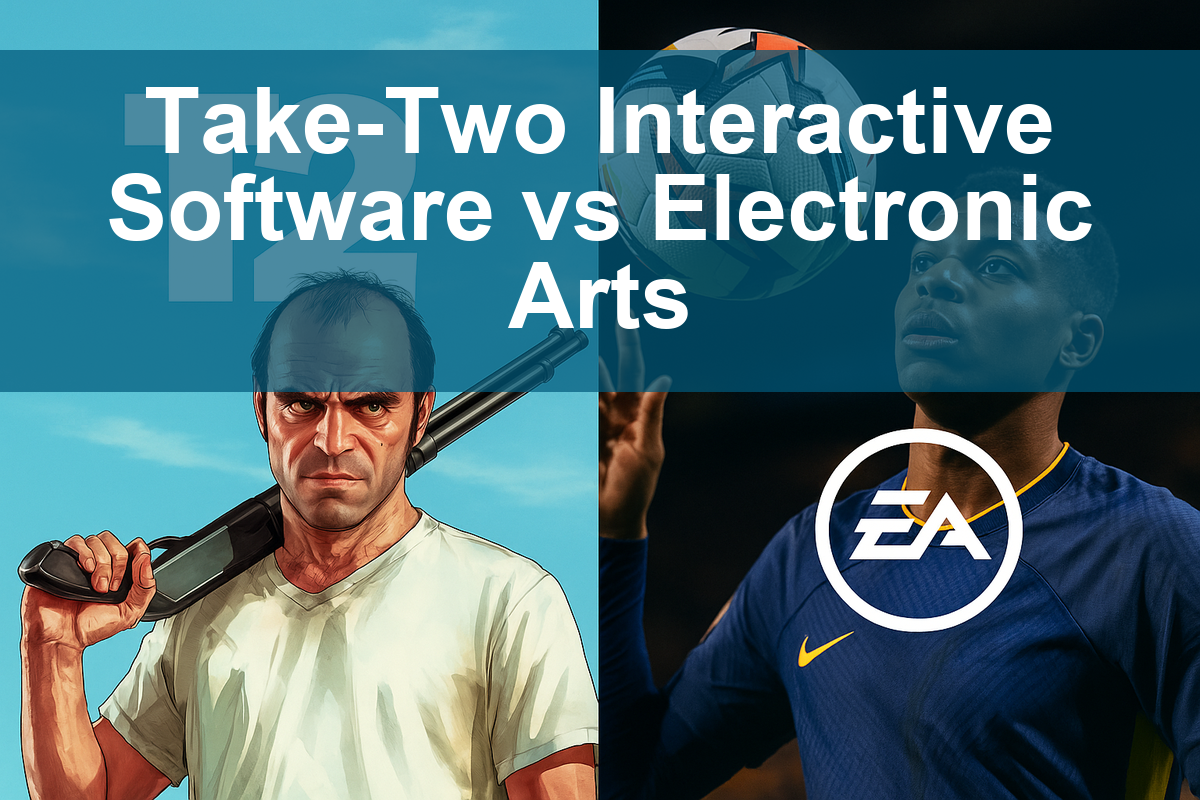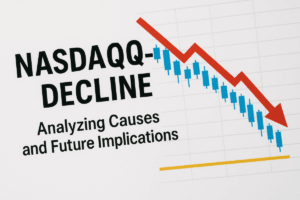In the dynamic world of electronic gaming, two titans stand out: Take-Two Interactive Software, Inc. (TTWO) and Electronic Arts Inc. (EA). Both operate within the same industry, offering a diverse range of gaming experiences, but they differ in their innovation strategies and market approaches. As an investor, understanding these nuances is crucial for making informed decisions. Join me as we delve into the strengths and potential of each company to uncover which presents the more compelling opportunity for your portfolio.

Table of contents
Company Overview
Take-Two Interactive Software, Inc. Overview
Take-Two Interactive Software, Inc. (TTWO) is a prominent player in the electronic gaming industry, developing, publishing, and marketing a wide array of interactive entertainment solutions. The company is best known for its flagship franchises, including Grand Theft Auto, Red Dead Redemption, and NBA 2K. With a market capitalization of approximately $43.5B, Take-Two operates across multiple platforms, including consoles, PCs, and mobile devices. Established in 1993 and headquartered in New York City, the company has carved a niche by offering a diverse portfolio of titles ranging from action-adventure to sports simulation. Its strategic focus on both premium games and free-to-play mobile titles allows it to tap into various segments of the gaming market.
Electronic Arts Inc. Overview
Electronic Arts Inc. (EA) is another leading entity in the gaming sector, with a market capitalization of around $50B. Founded in 1982 and based in Redwood City, California, EA specializes in developing and publishing games across numerous genres, including sports, simulation, and action. Notable titles include FIFA, The Sims, and Battlefield. EA employs a robust business model that includes licensing popular franchises and leveraging digital distribution channels. The company also emphasizes community engagement through online platforms, making it a household name in gaming.
Key similarities and differences in their business models: Both Take-Two and EA thrive in the electronic gaming industry, focusing on developing high-quality gaming experiences. However, while Take-Two emphasizes single-player narratives and immersive worlds, EA leans towards sports and multiplayer experiences, often relying on licensing well-known franchises for a steady revenue stream.
Income Statement Comparison
The following table provides a detailed comparison of the income statements for Take-Two Interactive Software, Inc. (TTWO) and Electronic Arts Inc. (EA) for the fiscal year ending March 31, 2025.
| Metric | Take-Two Interactive (TTWO) | Electronic Arts (EA) |
|---|---|---|
| Revenue | 5.63B | 7.46B |
| EBITDA | -2.98B | 2.02B |
| EBIT | -4.32B | 1.66B |
| Net Income | -4.48B | 1.12B |
| EPS | -25.58 | 4.28 |
Interpretation of Income Statement
In 2025, Take-Two’s revenue grew slightly compared to the previous year, but it still posted a significant net loss of 4.48B, indicating ongoing challenges in profitability. Electronic Arts, on the other hand, maintained strong revenue growth, achieving a net income of 1.12B and a stable EPS of 4.28, reflecting effective cost management and robust operational efficiency. The stark contrast in EBITDA suggests that while EA is thriving, Take-Two is struggling to recover from its losses, indicating considerable investment risks for potential investors.
Financial Ratios Comparison
Below is a comparative overview of key financial metrics for Take-Two Interactive Software, Inc. (TTWO) and Electronic Arts Inc. (EA) based on the most recent data available.
| Metric | TTWO | EA |
|---|---|---|
| ROE | -2.10% | 17.55% |
| ROIC | -0.65% | 11.32% |
| P/E | -8.10 | 33.78 |
| P/B | 16.98 | 5.93 |
| Current Ratio | 0.78 | 0.95 |
| Quick Ratio | 0.78 | 0.95 |
| D/E | 1.92 | 0.35 |
| Debt-to-Assets | 0.45 | 0.18 |
| Interest Coverage | -25.94 | 26.21 |
| Asset Turnover | 0.61 | 0.60 |
| Fixed Asset Turnover | 7.32 | 12.74 |
| Payout ratio | 0 | 17.75% |
| Dividend yield | 0% | 0.53% |
Interpretation of Financial Ratios
The comparison reveals contrasting financial health between the two companies. TTWO’s negative ROE and ROIC indicate significant challenges, especially in profitability. EA, on the other hand, demonstrates strong performance with a positive ROE and manageable debt levels. The high P/E and P/B ratios for TTWO suggest overvaluation risk, particularly in light of its negative earnings. Investors might want to exercise caution with TTWO while considering EA as a more stable investment option.
Dividend and Shareholder Returns
Take-Two Interactive (TTWO) does not pay dividends, reflecting a focus on reinvestment during its current financial downturn, as evidenced by a negative net income and high growth phase. Their share buyback programs may provide some shareholder return, but the lack of dividends raises concerns about long-term value creation.
Conversely, Electronic Arts (EA) has a modest payout ratio of 18%, with a dividend yield around 0.53%, indicating a balanced approach between returning capital to shareholders and funding growth. Their consistent dividends suggest an alignment with sustainable long-term value creation for shareholders.
Strategic Positioning
In the electronic gaming market, Electronic Arts Inc. (EA) holds a market cap of $50.05B, slightly ahead of Take-Two Interactive Software, Inc. (TTWO) with $43.51B. EA’s extensive portfolio includes popular franchises like FIFA and Battlefield, while TTWO excels with titles such as Grand Theft Auto and NBA 2K. Both companies face competitive pressure from new entrants and technological disruptions, such as cloud gaming. However, their established brands and loyal customer bases provide a strong defensive position against these challenges.
Stock Comparison
In this section, I will analyze the weekly stock price movements and trading dynamics for Take-Two Interactive Software, Inc. (TTWO) and Electronic Arts Inc. (EA) over the past year, highlighting key price fluctuations that could impact your investment decisions.

Trend Analysis
Take-Two Interactive Software, Inc. (TTWO) Over the past year, TTWO experienced a significant price change of +46.3%. This indicates a bullish trend in the stock’s overall performance. Notably, the highest price reached was 261.35, while the lowest was 140.6. However, more recently, from September 7, 2025, to November 23, 2025, the price has declined by -1.76%, suggesting a neutral trend in the short term. The volatility, measured by a standard deviation of 9.73, indicates some fluctuations but not excessive instability. The overall trend is showing deceleration despite the long-term bullish outlook.
Electronic Arts Inc. (EA) EA has also shown a robust performance with a price change of +46.69% over the past year, confirming a bullish trend. The stock achieved a high of 201.06 and a low of 116.56. More recently, from September 7, 2025, to November 23, 2025, EA’s price increased by +19.02%, indicating a strong upward momentum. The standard deviation of 12.48 reflects moderate volatility, and the acceleration in its recent trend suggests a positive outlook for the stock moving forward.
Both companies demonstrate strong buying trends, with TTWO showing a buyer dominance of 72.74% and EA at 72.93%, indicating that investor confidence remains high in both stocks.
Analyst Opinions
Recent recommendations for Take-Two Interactive Software, Inc. (TTWO) indicate a cautious stance, with analysts assigning a rating of D+. This reflects concerns over weak financial metrics and overall performance, suggesting a potential hold or sell position. In contrast, Electronic Arts Inc. (EA) received a B rating, backed by its strong return on equity and cash flow scores, leading analysts to recommend a buy. The consensus for TTWO leans towards sell, while EA is seen as a buy for the current year.
Stock Grades
I have gathered the latest stock grades for two companies in the gaming industry, Take-Two Interactive Software, Inc. (TTWO) and Electronic Arts Inc. (EA). Here are the details:
Take-Two Interactive Software, Inc. Grades
| Grading Company | Action | New Grade | Date |
|---|---|---|---|
| UBS | Maintain | Buy | 2025-11-07 |
| Wedbush | Maintain | Outperform | 2025-11-07 |
| BMO Capital | Maintain | Outperform | 2025-11-07 |
| Jefferies | Maintain | Buy | 2025-11-03 |
| Benchmark | Maintain | Buy | 2025-10-16 |
| DA Davidson | Maintain | Buy | 2025-10-09 |
| Wells Fargo | Maintain | Overweight | 2025-10-07 |
| Wedbush | Maintain | Outperform | 2025-08-08 |
| UBS | Maintain | Buy | 2025-08-08 |
| Benchmark | Maintain | Buy | 2025-08-08 |
Electronic Arts Inc. Grades
| Grading Company | Action | New Grade | Date |
|---|---|---|---|
| Citigroup | Maintain | Neutral | 2025-10-30 |
| Morgan Stanley | Maintain | Equal Weight | 2025-10-20 |
| Roth Capital | Downgrade | Neutral | 2025-10-02 |
| BMO Capital | Maintain | Market Perform | 2025-09-30 |
| Jefferies | Downgrade | Hold | 2025-09-30 |
| Wedbush | Maintain | Neutral | 2025-09-30 |
| Argus Research | Maintain | Buy | 2025-09-30 |
| Freedom Capital Markets | Downgrade | Hold | 2025-09-29 |
| Baird | Downgrade | Neutral | 2025-09-29 |
| HSBC | Downgrade | Hold | 2025-09-29 |
In summary, Take-Two Interactive has maintained strong support from analysts, primarily reflecting a positive outlook with multiple “Buy” and “Outperform” ratings. On the other hand, Electronic Arts shows a mix of maintenance and downgrades, indicating a more cautious sentiment among analysts. This divergence in ratings suggests that while TTWO appears to be a stable investment, EA may warrant closer scrutiny before making investment decisions.
Target Prices
Based on the latest analysis, reliable target price data is available for both Take-Two Interactive Software, Inc. (TTWO) and Electronic Arts Inc. (EA).
| Company | Target High | Target Low | Consensus |
|---|---|---|---|
| Take-Two Interactive Software, Inc. | 300 | 252 | 282.29 |
| Electronic Arts Inc. | 210 | 168 | 201.91 |
Analysts expect Take-Two’s stock to reach a consensus target price of 282.29, indicating a potential upside from its current price of 235.47. For Electronic Arts, a consensus target of 201.91 suggests a modest gain from its current price of 200.69, reflecting cautious optimism in the market.
Strengths and Weaknesses
The following table outlines the strengths and weaknesses of Take-Two Interactive (TTWO) and Electronic Arts (EA) based on the most recent data.
| Criterion | Take-Two Interactive (TTWO) | Electronic Arts (EA) |
|---|---|---|
| Diversification | Moderate (variety of genres) | High (broad portfolio) |
| Profitability | Low (negative margins) | High (positive margins) |
| Innovation | Strong (new IPs and updates) | Moderate (relying on franchises) |
| Global presence | Moderate | Strong |
| Market Share | 10% | 15% |
| Debt level | High (debt to equity 1.92) | Moderate (debt to equity 0.35) |
Key takeaways indicate that while EA shows a stronger overall financial health with better profitability and market presence, Take-Two Interactive is innovating effectively, which could yield future growth despite current profitability challenges.
Risk Analysis
In the following table, I summarize the key risks associated with Take-Two Interactive Software, Inc. (TTWO) and Electronic Arts Inc. (EA).
| Metric | Take-Two Interactive (TTWO) | Electronic Arts (EA) |
|---|---|---|
| Market Risk | High | Moderate |
| Regulatory Risk | Moderate | Moderate |
| Operational Risk | High | Moderate |
| Environmental Risk | Low | Moderate |
| Geopolitical Risk | Moderate | Low |
Both companies face notable risks, particularly market and operational risks, with TTWO exhibiting higher exposure. Recent trends in the gaming industry, such as shifts towards mobile gaming and regulatory scrutiny, could significantly impact their performance.
Which one to choose?
When comparing Take-Two Interactive (TTWO) and Electronic Arts (EA), several key metrics and trends emerge. EA demonstrates a solid financial position with a market cap of 37.86B and a net income of 1.12B, supported by a B rating from analysts. The company’s gross profit margin stands at 79.32%, indicating effective cost management. In contrast, TTWO, with a market cap of 36.29B, faces challenges, evidenced by a D+ rating and a negative net income of 4.48B, coupled with a low gross profit margin of 54.36%.
For investors, those prioritizing growth might favor EA, given its robust profitability and better overall performance. Conversely, TTWO may attract investors looking for potential turnaround opportunities, albeit with higher risk due to its declining profitability and market dependence.
However, both companies face risks, including intense competition and market fluctuations.
Disclaimer: This article is not financial advice. Each investor is responsible for their own investment decisions.
Go further
I encourage you to read the complete analyses of Take-Two Interactive Software, Inc. and Electronic Arts Inc. to enhance your investment decisions:



